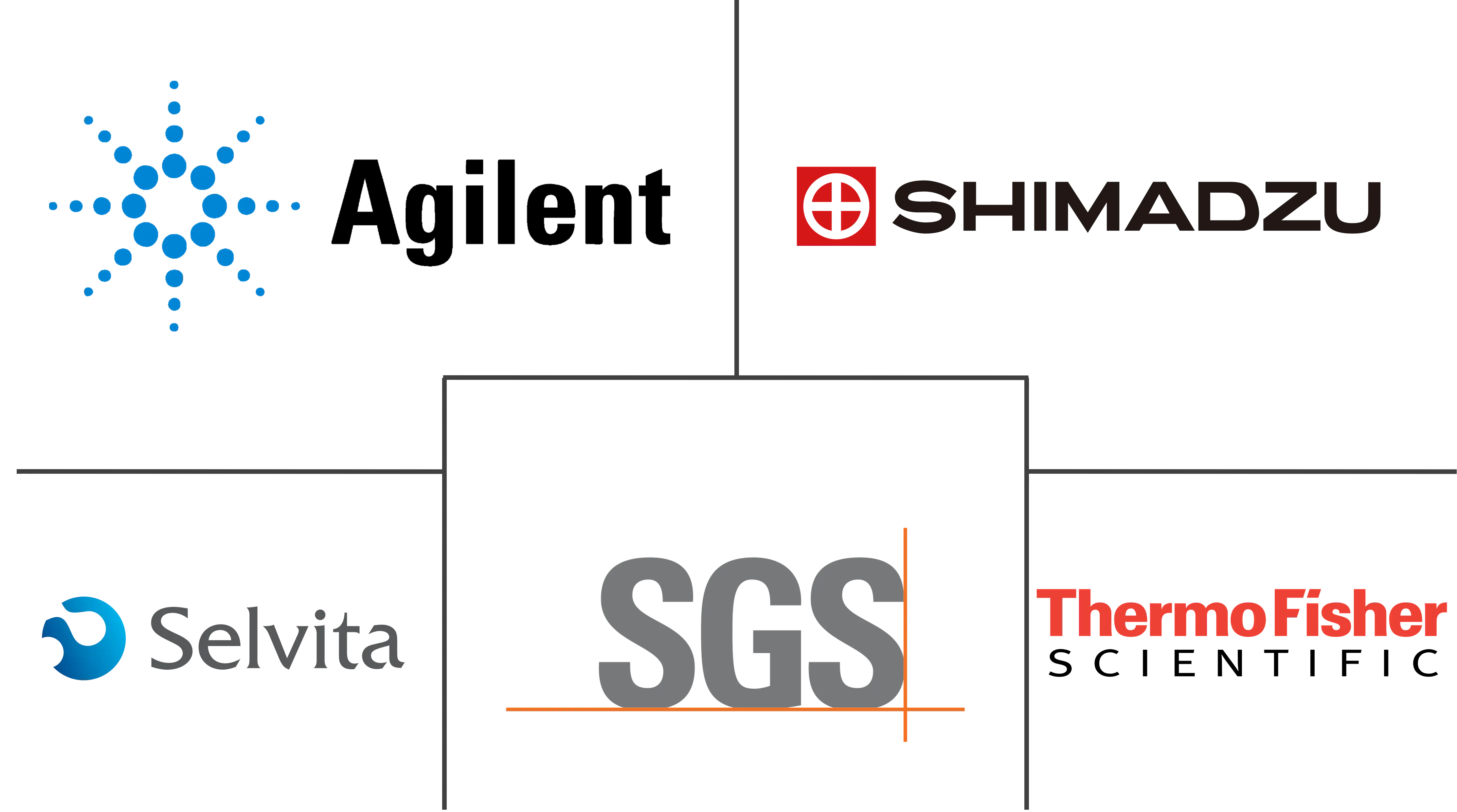Protein Sequencing Market Size and Share
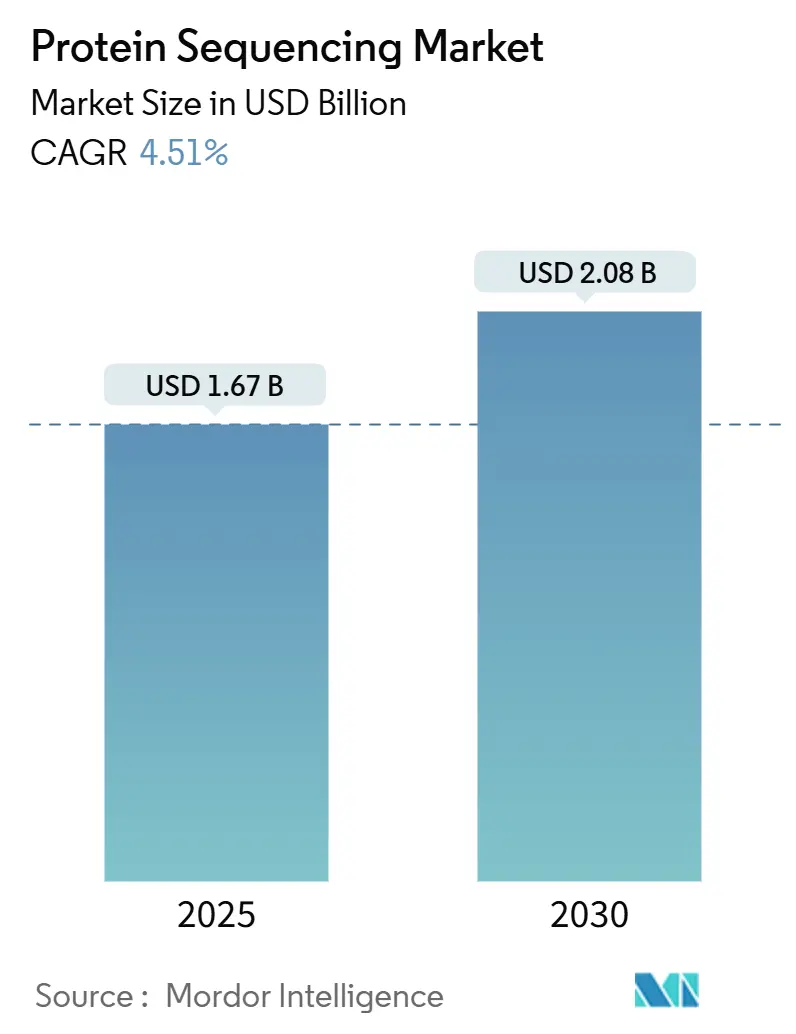
Protein Sequencing Market Analysis by Mordor Intelligence
The Protein Sequencing Market size is estimated at USD 1.67 billion in 2025, and is expected to reach USD 2.08 billion by 2030, at a CAGR of 4.51% during the forecast period (2025-2030).
Demand growth reflects an ecosystem shift from classical mass-spectrometry workflows toward single-molecule approaches that reveal protein variants and post-translational modifications in real time. Pharmaceutical companies deepen adoption to accelerate target validation, while Contract Research Organizations (CROs) capture incremental outsourcing budgets. Platform developers bundle instruments with consumables and analytics software, turning reagent sales into recurring revenue streams that cushion price pressure on hardware. North America retains spending leadership through entrenched R&D infrastructure, yet Asia-Pacific outpaces all regions in growth as local biopharma investment rises and regulatory pathways align with global norms.
Key Report Takeaways
- By products & services, software & services held 38.83% revenue share in 2024; reagents & consumables is expanding at a 7.63% CAGR through 2030.
- By application, biotherapeutics quality control & discovery captured 36.61% of protein sequencing market share in 2024, while synthetic biology & cell-free systems is projected to climb at a 12.32% CAGR to 2030.
- By end user, pharmaceutical companies commanded 53.78% share of the protein sequencing market size in 2024, whereas CROs record the fastest 8.59% CAGR during the forecast period.
- By geography, North America led with a 43.63% share in 2024; Asia-Pacific is set to advance at an 8.83% CAGR to 2030.
Global Protein Sequencing Market Trends and Insights
Drivers Impact Analysis
| Driver | (~) % Impact on CAGR Forecast | Geographic Relevance | Impact Timeline |
|---|---|---|---|
| Rising prevalence of chronic diseases | +1.2% | Global, concentrated in North America & Europe | Medium term (2-4 years) |
| Advancements in sequencing technologies | +1.8% | Global, led by North America & Asia-Pacific | Short term (≤ 2 years) |
| Growing focus on target-based drug development | +1.1% | North America & Europe, expanding to Asia-Pacific | Medium term (2-4 years) |
| Increased R&D funding in proteomics | +0.9% | Global, particularly North America & China | Long term (≥ 4 years) |
| Expanding applications in biotherapeutics | +1.3% | Global, early adoption in developed markets | Medium term (2-4 years) |
| Decreasing cost of sequencing services | +0.7% | Global, faster uptake in emerging markets | Long term (≥ 4 years) |
| Source: Mordor Intelligence | |||
Rising Prevalence of Chronic Diseases
Escalating burdens of cancer, cardiovascular disorders, and neurodegeneration push healthcare systems to augment genomic data with proteomic insight. The UK Biobank initiated a 2025 study profiling 5,400 proteins across 600,000 samples, laying the groundwork for large-scale correlation between circulating proteins and clinical outcomes.[1]UK Biobank, “UK Biobank proteomics study transforms population health research,” ukbiobank.ac.uk Early-stage cancer screening shows pronounced benefit: plasma-based multi-cancer tests reached 93% sensitivity in men and 84% in women, eclipsing many current modalities. Combining proteome, genome, and imaging layers fuels AI models that sharpen risk prediction and drive demand within the protein sequencing market. Pharmaceutical companies, already holding 53.78% share, integrate these datasets to prioritise therapeutic targets and stratify trial populations.
Advancements in Sequencing Technologies
Single-molecule innovations are redefining technical limits. Oxford Nanopore Technologies reported >98% accuracy in identifying protein variants with a prototype pore-based system.[2]Oxford Nanopore Technologies, “Advances in protein sequencing accuracy,” nanoporetech.comQuantum-Si commercialised this vision through the Platinum Pro benchtop sequencer launched in 2025, coupling semiconductor chips with machine-learning-guided base-calling. On the software side, deep-learning models such as InstaNovo now deliver 90.5% peptide sequencing accuracy from sparse amino-acid reads, dramatically shortening analysis cycles. Increased analytic power underpins the 7.63% CAGR rise in reagent demand as users run larger sample volumes to exploit newfound resolution.
Growing Focus on Target-Based Drug Development
Strategic pipelines prioritise protein structure and function rather than gene expression alone. Generate Biomedicines raised USD 700 million to design therapeutic proteins with generative AI, advancing two molecules to clinical testing by 2025. The US FDA refined guidance on recombinant biologics, clarifying requirements for sequence validation and comparability studies.[3]Food and Drug Administration, “Guidance for industry: recombinant therapeutic proteins,” fda.gov Cell-free protein synthesis accelerates optimisation loops and sustains a 12.32% CAGR within synthetic-biology applications. Researchers also deploy computational design to craft enzymes showing 100-fold efficiency gains over previous AI efforts, broadening the protein sequencing market scope beyond analytics into engineering.
Increased R&D Funding in Proteomics
Cross-sector funding has multiplied. Fourteen biopharma companies bankroll the UK Biobank proteomics project, underscoring shared interest in population-scale protein data. Glyphic Biotechnologies secured USD 39.2 million to advance a single-molecule platform, illustrating investor confidence in next-generation approaches. Academic-industry partnerships flourish; Northwestern Proteomics Center adopted Quantum-Si’s chip-based system to interrogate proteoforms in neurodegenerative disease. Sustained capital flows enable technology maturation and expand the protein sequencing market user base.
Restraints Impact Analysis
| Restraint | (~) % Impact on CAGR Forecast | Geographic Relevance | Impact Timeline |
|---|---|---|---|
| High cost of instruments and services | -1.4% | Global, particularly emerging markets | Short term (≤ 2 years) |
| Complexity of data interpretation | -0.8% | Global, steeper in regions with limited expertise | Medium term (2-4 years) |
| Regulatory hurdles | -0.6% | Primarily North America & Europe | Medium term (2-4 years) |
| Limited standardisation across platforms | -0.5% | Global, affects interoperability | Long term (≥ 4 years) |
| Source: Mordor Intelligence | |||
High Cost of Instruments and Services
Front-end capital remains a gating factor. Flagship single-molecule sequencers list upwards of USD 500,000 per unit, while consumables can add USD 50 per sample for deep proteome coverage. The FDA’s 2024 staff reductions inflated review timelines, indirectly raising compliance costs for newcomers. These economics motivate drug developers to engage CROs, whose 8.59% CAGR reflects an outsourcing preference that tempers direct instrument sales. Vendors counter by offering subscription financing and reagent rental plans, yet affordability gaps persist in price-sensitive markets.
Complexity of Data Interpretation
Proteome data sets dwarf genomic counterparts in scale and heterogeneity. While protein language models improve annotation fidelity, limited labelled data and model explainability impede adoption. Organisations lacking bioinformatics talent face bottlenecks even after hardware acquisition, propelling Software & Services to 38.83% market share. Platform suppliers now deliver turnkey pipelines that integrate sample prep, sequencing, and AI analytics, though mastering downstream biological context still demands expert oversight.
Segment Analysis
By Products & Services: Software Integration Drives Platform Adoption
The segment generated the largest contribution to the protein sequencing market in 2024, with Software & Services accounting for 38.83% of revenue. Instruments remain essential, but value increasingly migrates to cloud analytics subscriptions that translate complex spectra into actionable readouts. Growth accelerates in Reagents & Consumables, which expand at a 7.63% CAGR as single-molecule workflows rely on branded chips and chemistry kits. Integrated ecosystems create vendor lock-in that stabilises recurring turnover and underpins predictable cash flows for suppliers.
Customers now prioritise end-to-end solutions that bundle assay kits, AI algorithms, and workflow automation. Developers embed real-time quality metrics and adaptive chemistries, shortening run times and reducing failed experiments. Over the forecast window, instrument margins may compress as competition rises, while software-as-a-service models and reagent volumes sustain profitability. As a result, the protein sequencing market is expected to experience a broader shift toward service-centred revenue without diluting ongoing hardware innovation.
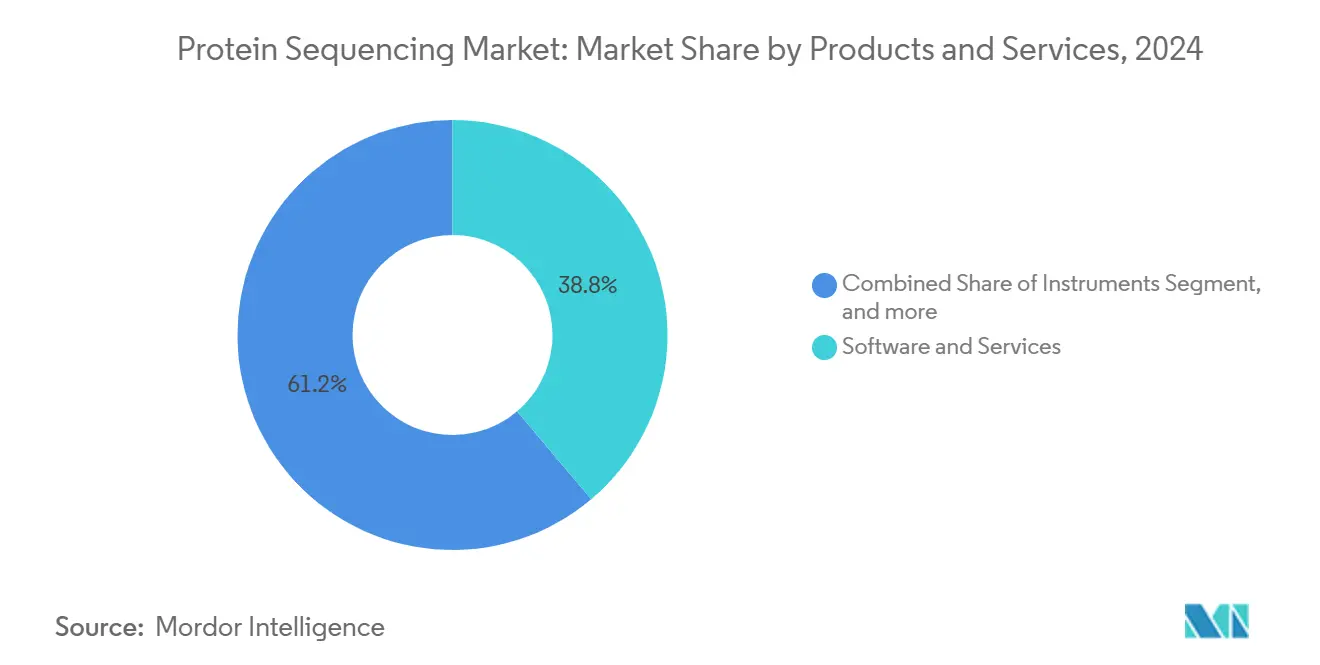
Note: Segment shares of all individual segments available upon report purchase
By Application: Synthetic Biology Emerges as Growth Engine
Synthetic Biology & Cell-free Systems is the fastest-expanding use case, growing at 12.32% CAGR and steadily enlarging its share within the protein sequencing market. Demand is driven by rapid prototyping of therapeutic enzymes and vaccine antigens, which benefit from cell-free platforms that bypass cloning cycles and expedite functional testing. Biotherapeutics Quality Control & Discovery preserved the leading 36.61% share due to regulatory mandates for sequence confirmation and impurity profiling across monoclonal antibodies, fusion proteins, and bispecific formats.
Breakthroughs in enzyme engineering demonstrate why single-molecule accuracy matters: computational redesign achieved 100-fold catalytic gains relative to earlier AI-guided efforts, validating proteome sequencing as a critical feedback tool. Growing sensitivity further enables biomarker discovery in oncology and neurodegeneration, extending the technology’s impact into clinical diagnostics. Overall, the protein sequencing market size for application segments exhibits a characteristic barbell pattern, pairing steady demand in quality control with outsized growth from synthetic biology.
By End User: CROs Capitalize on Outsourcing Trends
Pharmaceutical companies retained a dominant 53.78% share of the protein sequencing market in 2024, underpinned by pipeline breadth and budget size. Yet CROs register the quickest 8.59% CAGR as they absorb tasks that require specialised personnel and high-capex instruments. This shift reflects internal cost-containment priorities and the desire for variable rather than fixed R&D expenditure.
Academic institutes extend capabilities through shared core facilities but frequently partner with CROs for large-scale studies, mirroring biopharma’s outsourcing behaviour. Biotechnology startups leverage CRO-led services to access proteomics early without spending scarce venture capital on equipment. Over time, the market may bifurcate between integrated R&D giants with in-house platforms and a services layer that blankets smaller innovators. Both cohorts, however, will continue to drive reagent consumption and software utilisation, sustaining expansion of the overall protein sequencing market.
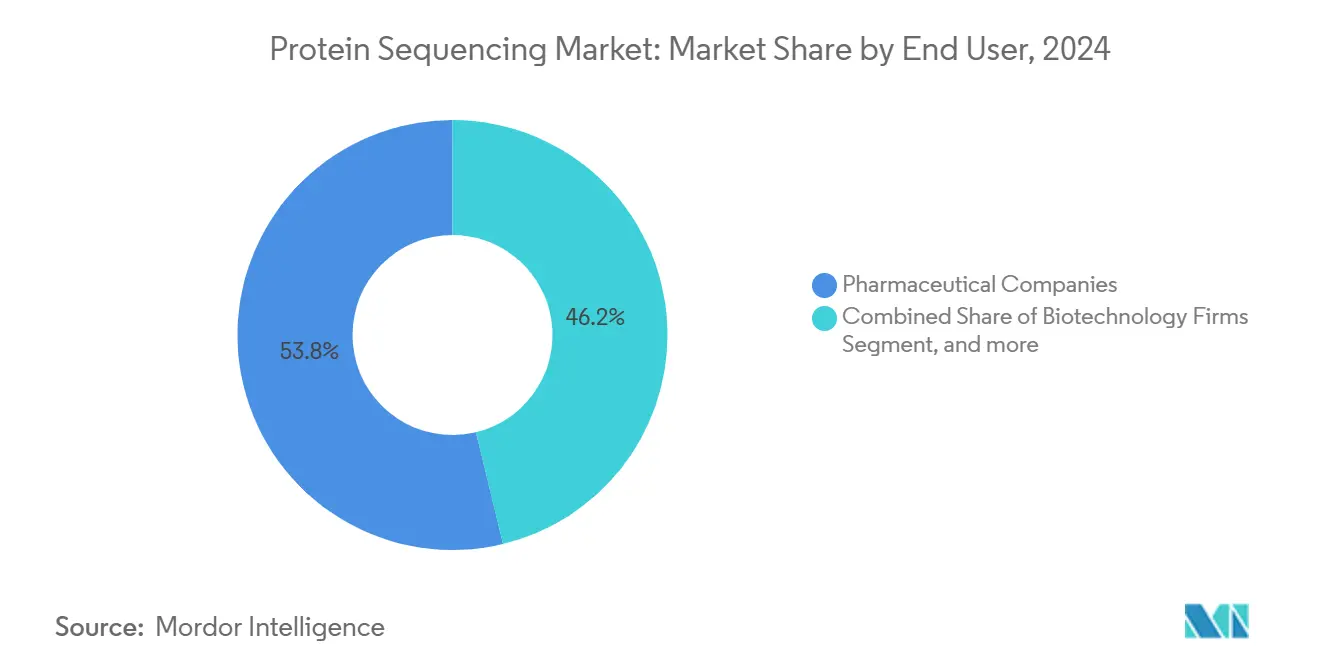
Note: Segment shares of all individual segments available upon report purchase
Geography Analysis
North America generated 43.63% of revenue in 2024, benefiting from deep venture capital pools, corporate R&D clustering, and established regulatory pathways. Leading suppliers such as Thermo Fisher Scientific and Quantum-Si operate extensive manufacturing and support networks that reinforce regional dominance. Nevertheless, high labour and operational costs temper incremental growth, resulting in a mid-single-digit CAGR across the outlook period.
Asia-Pacific is the fastest mover with an 8.83% CAGR, propelled by government initiatives that underwrite local biomanufacturing capacity and streamline ethics review for multi-centre studies. China finances large-scale biotechnology parks, while Japan, South Korea, and India expand academic-industry collaborations. The influx of multinational clinical trials stimulates demand for high-throughput proteomics, enlarging the regional protein sequencing market.
Europe exhibits steady progress, anchored by long-standing proteomics centres and pan-EU funding mechanisms such as Horizon Europe. Harmonised documentation standards facilitate cross-border sample exchange, which enables consortium-driven discovery efforts. Markets in South America, the Middle East, and Africa remain emergent but show promise as diagnostics programmes expand and public health agencies recognise the value of protein-level surveillance. Collectively, geographic diversification cushions suppliers against cyclical spending patterns and broadens the global protein sequencing market footprint.
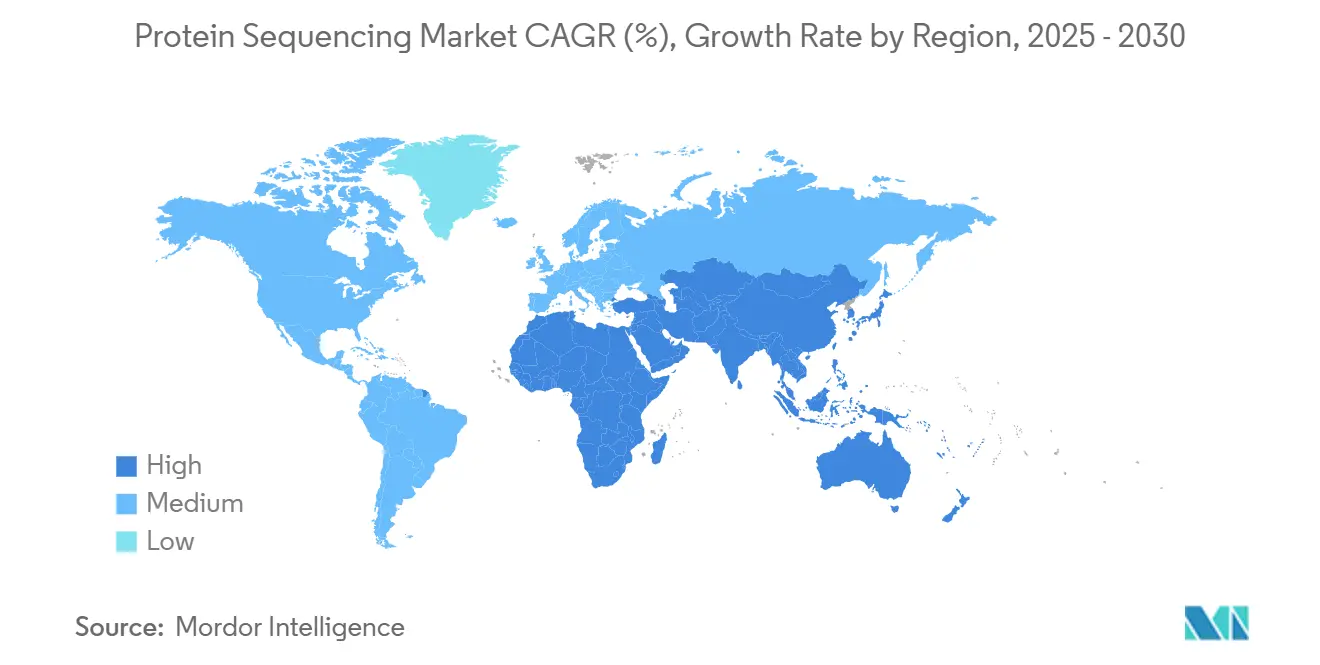
Competitive Landscape
The competitive field features a mix of diversified instrument vendors and venture-backed specialists. Thermo Fisher’s USD 3.1 billion purchase of Olink in 2024 extended its reach into proximity-based protein assays and signalled rising consolidation among incumbents. Agilent, Waters, and Bruker defend share through incremental mass-spectrometry upgrades and bundled informatics. Emerging entrants including Quantum-Si, Encodia, and Erisyon focus on semiconductor chips, fluorescent barcodes, or time-of-flight nanopore readouts that promise single-molecule precision.
Strategic alliances proliferate: Quantum-Si signed distribution pacts with Avantor to widen laboratory access across North America. Meanwhile, AI platform providers court hardware makers to embed predictive algorithms directly within run control software, sharpening competitive differentiation. Price competition intensifies in mid-throughput instruments where multiple players now offer comparable specifications. Yet high-end single-molecule systems remain differentiated by chemistry fidelity, throughput, and ecosystem maturity, giving first movers a defensible moat.
Going forward, success will hinge on integrated value propositions that knit instruments, reagents, and cloud analytics into cohesive user experiences. Suppliers able to flatten learning curves and lower total cost of ownership are poised to capture incremental share. Venture funding momentum and technological breakthroughs suggest additional mergers or strategic partnerships as companies seek scale and complementary capabilities within the protein sequencing market.
Protein Sequencing Industry Leaders
-
Agilent Technologies, Inc.
-
SGS SA
-
Shimadzu Corporation
-
Thermo Fisher Scientific Inc.
-
Selvita SA
- *Disclaimer: Major Players sorted in no particular order



Recent Industry Developments
- June 2025: Formation Bio announced the launch of its AI tool Muse in partnership with OpenAI and Sanofi to accelerate drug development, particularly for multiple sclerosis treatments, leveraging generative AI for protein mapping and creation. The partnership represents a significant advancement in AI-driven protein design capabilities.
- May 2025: Quantum-Si reported 84% revenue increase in Q1 2025 compared to Q1 2024, demonstrating strong market traction for its Next-Generation Protein Sequencing platform. The company expanded its international channel partner network to 23 partners and remains on track for successful protein sequencing on a prototype system by end of 2025.
- January 2025: Quantum-Si launched the Platinum Pro, an advanced benchtop sequencer for enhanced protein analysis in proteomics research, featuring an enlarged touchscreen interface and Pro Mode for custom application development. The system shipped in Q1 2025 with distribution partnership through Avantor for the U.S. and Canada markets.
- January 2025: UK Biobank launched the world's largest proteomics study, analyzing up to 5,400 proteins across 600,000 samples with funding from 14 biopharmaceutical companies. The study will combine proteomic data with genetic and imaging information to facilitate AI model development for disease prediction.
Research Methodology Framework and Report Scope
Market Definitions and Key Coverage
Our study defines the protein sequencing market as revenues generated from instruments, reagents, consumables, and dedicated software or analytical services that determine full or partial amino-acid chains of purified proteins or peptides for research, clinical, or industrial use. According to Mordor Intelligence, the market was valued at USD 1.67 billion in 2025 and is projected to reach USD 2.08 billion by 2030.
Scope Exclusion: routine peptide mapping performed only as a secondary QC step in standard mass-spectrometry workflows is excluded.
Segmentation Overview
- By Products & Services
- Instruments
- Mass Spectrometry
- Edman Degradation Systems
- Single-Molecule Sequencers
- Reagents & Consumables
- Software & Services
- Instruments
- By Application
- Biomarker Discovery
- Protein Engineering Studies
- Biotherapeutics QC & Discovery
- Synthetic Biology & Cell-free Systems
- Others
- By End User
- Pharmaceutical Companies
- Biotechnology Firms
- Contract Research Organizations
- Academic & Research Institutes
- Others
- By Geography
- North America
- United States
- Canada
- Mexico
- Europe
- Germany
- United Kingdom
- France
- Italy
- Spain
- Rest of Europe
- Asia-Pacific
- China
- Japan
- India
- Australia
- South Korea
- Rest of Asia-Pacific
- Middle East & Africa
- GCC
- South Africa
- Rest of Middle East & Africa
- South America
- Brazil
- Argentina
- Rest of South America
- North America
Detailed Research Methodology and Data Validation
Primary Research
Mordor analysts interviewed proteomics core-facility managers in Boston, Basel, Singapore, and Hyderabad, senior scientists in biotherapeutic discovery groups, and procurement heads at contract research organizations. These conversations validated unit pricing tiers and utilization rates, and indicated that upgraded mass-spectrometry platforms are replacing Edman systems faster in Asia than in North America.
Desk Research
We began with public datasets from agencies such as the NIH RePORTER grant registry, Eurostat trade codes for HS 2843 90 reagents, and the Chinese Ministry of Science & Technology project lists, which helped us benchmark funding volumes feeding instrument demand. Statistics from the World Intellectual Property Organization patent portal clarified technology diffusion timelines, while articles in journals like Proteomics and Nature Methods revealed adoption rates for single-molecule sequencers. Company 10-K filings, investor decks, and association portals (e.g., the Human Proteome Organization) supplied shipment counts and average selling prices. Inputs were further cross-checked against paid resources including D&B Hoovers for supplier revenues and Dow Jones Factiva for recent product launch news. This list is illustrative; many additional open and subscription sources informed our desk analysis.
Market-Sizing & Forecasting
We first applied a top-down reconstruction that allocates global life-science R&D outlays to proteomics spending and then to sequencing equipment, reagents, and services. Selective bottom-up checks, install-base roll-ups from major vendors, and sampled ASP × volume validations fine-tuned totals. Key variables in our multivariate regression model include installed mass-spectrometry base, biotherapeutic clinical pipeline counts, number of active proteomics labs, and regional research grant disbursements; their five-year trajectories drive the 4.51 % CAGR. Where supplier data were partial, gaps were bridged using median utilization factors derived from interview averages.
Data Validation & Update Cycle
Outputs run through variance screens that flag deviations above two standard deviations from historical trends; flagged items trigger re-contact with field experts before sign-off. Reports refresh every twelve months, with interim adjustments when material events, such as major funding bills and significant technology launches, occur.
Why Mordor's Protein Sequencing Baseline Commands Decision-Makers' Trust
Published numbers vary because firms pick different product mixes, data years, and growth assumptions. We clarify scope upfront, refresh annually, and reconcile top-down totals with tangible bottom-up indicators, giving users a balanced reference point.
Benchmark comparison
| Market Size | Anonymized source | Primary gap driver |
|---|---|---|
| USD 1.67 Bn (2025) | Mordor Intelligence | |
| USD 1.43 Bn (2024) | Regional Consultancy A | Older base year and narrower geographic coverage limit comparability |
| USD 2.39 Bn (2025) | Global Consultancy B | Includes adjacent proteomics services and applies an aggressive ASP uplift |
The comparison shows how differing scopes and price assumptions quickly swing totals. Our disciplined variable selection, timely updates, and transparent cross-checks give stakeholders a dependable baseline they can trace and reproduce with confidence.


Key Questions Answered in the Report
What is the current value of the protein sequencing market?
The protein sequencing market size is USD 1.67 billion in 2025 and is projected to reach USD 2.08 billion by 2030.
Which segment is expanding fastest within the market?
Synthetic Biology & Cell-free Systems leads growth with a 12.32% CAGR through 2030.
Why are Contract Research Organizations gaining ground?
CROs grow at 8.59% CAGR because they offer specialised expertise and eliminate the need for drug developers to invest in high-cost instruments.
Which region holds the largest market share?
North America accounts for 43.63% of 2024 revenue owing to entrenched R&D infrastructure and a dense supplier base.
What technology trends are reshaping the competitive landscape?
Single-molecule sequencing, AI-powered data interpretation, and integrated instrument-software ecosystems drive differentiation and vendor consolidation.
How are high instrument costs being addressed?
Vendors introduce subscription financing, reagent rental models, and cloud-based analytics bundles to lower upfront capital and operational barriers.
Page last updated on:
